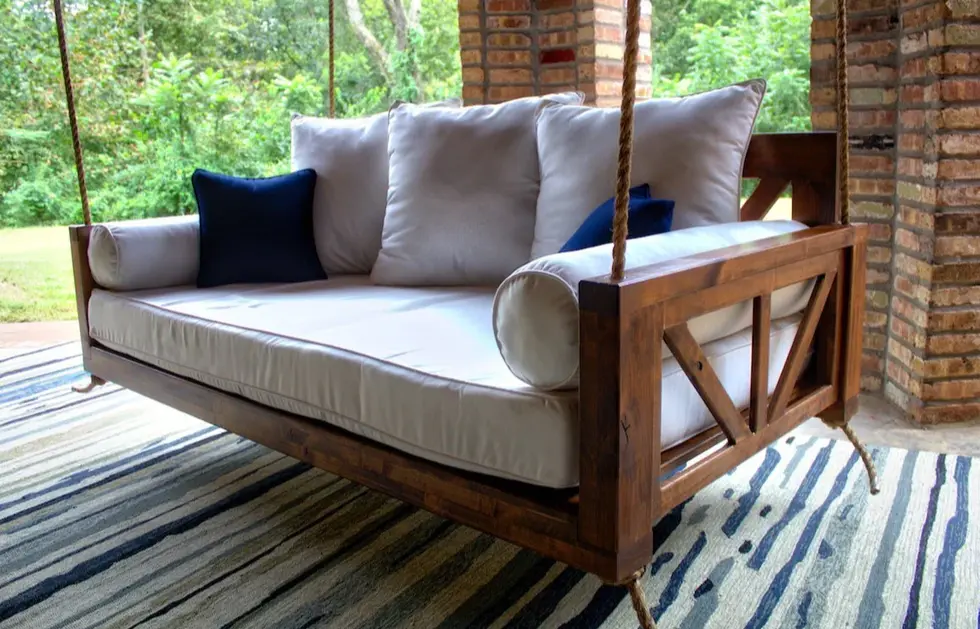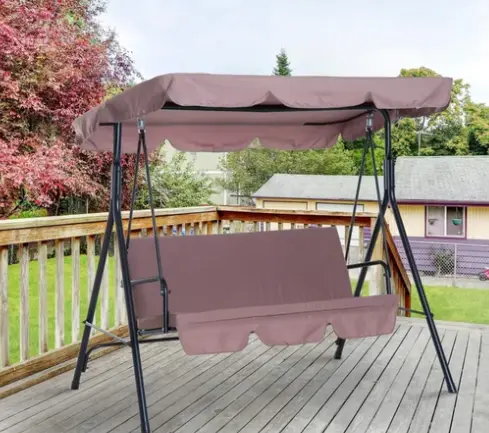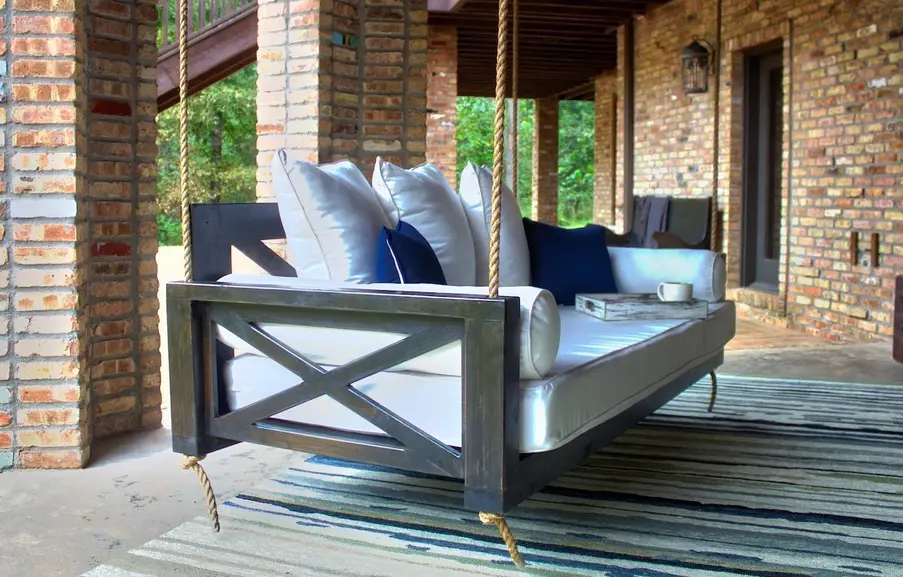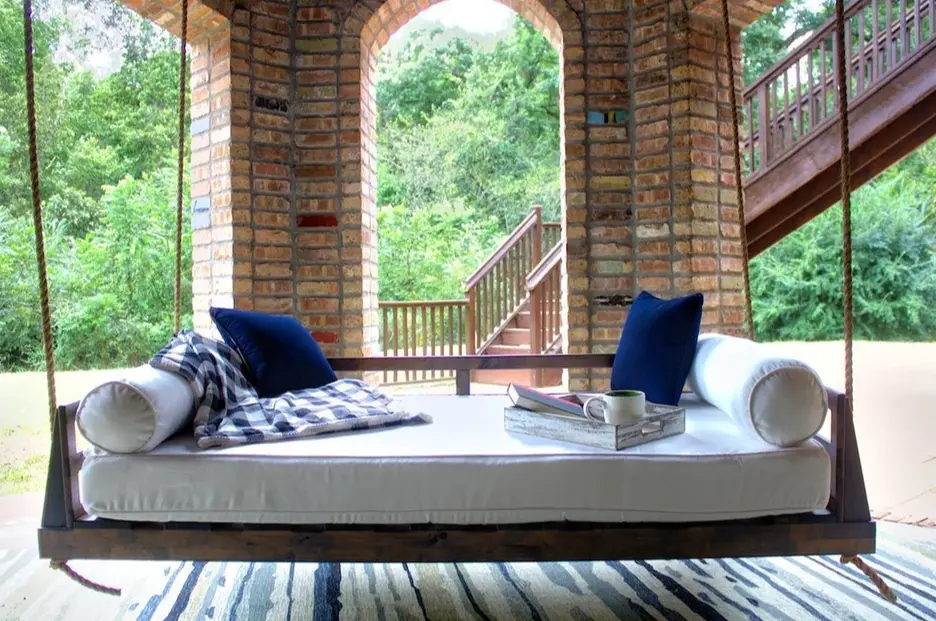Porch swings! They’re the epitome of leisure, a timeless piece of outdoor furniture that invites you to sit back and enjoy life’s simple pleasures. But hold on a minute—before you get too comfy, have you ever thought about what type of wood your swing is made of? Wood quality can make or break your swinging experience, literally and metaphorically. So, let’s delve into the world of wooden porch swings and explore how to pick the best wood for your outdoor oasis.
Types of Wood for Porch Swings: A Comprehensive Guide
Cedar: The All-Rounder
Pros:
- Naturally resistant to rot, insects, and warping
- Rich red color adds warmth to your outdoor space
- Long-lasting if properly cared for
Cons:
- It may not last as long as teak
- Requires some maintenance
Why Choose Cedar?
Cedar is a popular choice for outdoor furniture, including porch swings. Its natural resistance to rot, insects, and warping makes it durable. The wood is also rich red, adding warmth to your outdoor space. However, it may not last as long as teak but can still last a couple of decades if cared for properly.
Teak: The Luxury Choice
Pros:
- Highly resilient in any season
- Produces its oils, requiring little to no maintenance
- Soft, grained finish adds a touch of elegance
Cons:
- Expensive
- May require annual cleaning
Why Choose Teak?
Teak is often recommended for wooden outdoor furniture due to its resilience and style. The wood produces its oils, making it unique compared to other types of natural wood. This also means it requires little to no maintenance, although an annual cleaning is recommended to keep it in top condition.
Cypress: The Visual Impact
Pros:
- Light wood with a gorgeous grain
- Enough oil content to resist water and rotting
- Weathers a silver-grey color over time if left unfinished
Cons:
- Softer wood, may not be as durable as others
- Can be expensive
Why Choose Cypress?
Cypress is a softer wood but a great option for wooden outdoor furniture. Its light wood and gorgeous grain make for a great visual impact. The wood also has enough oil content to resist water and rotting.
Oak: The Classic
Pros:
- Extremely durable
- Classic look and feel
- Resistant to insect and fungal attack
Cons:
- Heavy
- Requires regular maintenance
Why Choose Oak?
Oak is a classic choice for furniture, known for its extreme durability and resistance to insect and fungal attacks. However, it is heavy and requires regular maintenance to keep it in good condition.
Pine: The Budget-Friendly Option
Pros:
- Affordable
- Lighter than other woods
- Easy to paint or stain
Cons:
- Less durable
- Susceptible to rot and insects
Why Choose Pine?
Pine is a budget-friendly option but comes with its own set of drawbacks. It’s less durable than other wood types and susceptible to rot and insects. However, it’s lighter and easier to paint or stain, making it a versatile choice.
Teak vs. Cedar vs. Cypress vs. Oak vs. Pine: At a Glance
| Wood Type | Durability | Maintenance | Aesthetic Appeal | Cost |
| Teak | High | Low | High | High |
| Cedar | Medium | Medium | High | Medium |
| Cypress | Medium | Low | High | High |
| Oak | High | High | Medium | High |
| Pine | Low | High | Medium | Low |
Is Pine Suitable for a Porch Swing? Weighing the Pros and Cons
Pine is an evergreen gymnosperm that belongs to the softwood group. It thrives in various climates, from tropical forests to semi-arid deserts. Pine trees are native to the Northern Hemisphere and can also be found in various regions of Vietnam. The wood is generally straight-grained with a medium texture, although some types may have uneven texture and knots. The heartwood is light brown, while the sapwood is a lighter yellowish-white.
The Good, The Bad, and The Piney
Pros of Using Pine for Porch Swings
- Affordability: Pine is generally less expensive than other types of wood like cedar or teak, making it a budget-friendly option.
- Workability: Pine is relatively easy to work with, whether you want to paint, stain, or carve it.
- Adaptability: Pine is less prone to shrinkage or swelling in humid environments than hardwoods.
- Lightweight: Being lighter than other woods, pine is easier to move and install.
Cons of Using Pine for Porch Swings
- Durability: Pine is a softwood, which means it’s not as durable as hardwoods like oak or teak.
- Susceptibility to Rot and Insects: Pine is not naturally resistant to rot and insects, unlike cedar or teak.
- Maintenance: Over time, pine wood will require preservation and maintenance to limit wear and tear.
- Appearance: The presence of knots and uneven texture in some types of pine may not be appealing to everyone.
Pine vs. Other Woods: A Quick Comparison
| Features | Pine | Cedar | Teak | Oak |
| Durability | Low | Medium | High | High |
| Maintenance | High | Medium | Low | High |
| Cost | Low | Medium | High | High |
| Aesthetic Appeal | Medium | High | High | Medium |
Materials for Porch Swings: Wood and Its Alternatives
When it comes to porch swings, wood has been the go-to material for ages. But times are changing, and so are the materials used to craft these cozy outdoor seats. From metal to plastic and even fabric, the options are expanding. So, let’s break down the pros and cons of wood and its alternatives to help you make an informed decision.
Wooden Swings: The Timeless Classic
Pros:
- Natural aesthetic that blends well with outdoor settings
- Variety of wood types to choose from, each with unique properties
- Generally durable and can be long-lasting with proper care
Cons:
- Requires regular maintenance to prevent rot and insect damage
- Can be expensive depending on the wood type
Why Choose Wood?
Wooden swings offer a timeless aesthetic and a natural feel. They are generally durable and can last for years if properly maintained. However, they require regular upkeep to prevent rot and insect damage.
Metal Swings: The Sturdy Alternative
Pros:
- Highly durable and resistant to weather conditions
- Low maintenance
- Modern aesthetic
Cons:
- Can rust if not properly treated
- May not offer the same level of comfort as wood
Why Choose Metal?
Metal swings are incredibly durable and require less maintenance than wood. They are an excellent option for those who prefer a more modern look. However, they can rust if not properly treated and may not offer the same comfort level as wooden swings.
Plastic Swings: The Eco-Friendly Option
Pros:
- Often made from recycled materials
- Resistant to weather conditions
- Low maintenance
Cons:
- May not offer the same aesthetic appeal as wood or metal
- Durability can vary
Why Choose Plastic?
Plastic swings are often made from recycled materials, making them an eco-friendly option. They are also low maintenance and weather-resistant. However, they may lack the aesthetic appeal of wood or metal swings.
Fabric Swings: The Comfort King
Pros:
- Extremely comfortable
- Easy to clean
- Can be easily replaced
Cons:
- Not as durable as other materials
- May fade or deteriorate quickly in harsh weather conditions
Why Choose Fabric?
Fabric swings offer the highest level of comfort among all materials. They are easy to clean and can be easily replaced. However, they are not as durable as other materials and may not withstand harsh weather conditions.
Wood vs. Metal vs. Plastic vs. Fabric: A Quick Comparison
| Material | Durability | Maintenance | Aesthetic Appeal | Eco-Friendly |
| Wood | High | High | High | Varies |
| Metal | High | Low | Medium | No |
| Plastic | Medium | Low | Low | Yes |
| Fabric | Low | Medium | High | Varies |
Building and Designing Porch Swings: A Comprehensive Guide
Building a porch swing is not just about nailing some planks together; it’s an art that combines aesthetics, comfort, and safety. Whether you’re a DIY enthusiast or looking to hire a professional, understanding the basic construction and design principles can go a long way.
DIY Tips: Crafting Your Swing
Tools You’ll Need:
- Measuring tape
- Saw
- Drill
- Screws and nails
- Sandpaper
- Paint or stain
Steps:
- Measure and Cut: Start by measuring the space where the swing will go. Cut your wood pieces according to the dimensions.
- Assemble the Frame: Use screws and nails to assemble the frame. Make sure it’s sturdy.
- Add the Seat and Back: Attach the seat and back to the frame.
- Sand and Finish: Sand the wood to remove any rough edges. Finish with paint or stain.
- Install: Use heavy-duty hooks to install your swing.
Why DIY?
Building your swing allows you to customize it according to your needs. You can choose the material, size, and design, making it a unique piece.
Professional Construction: When to Call the Experts
Pros:
- High-quality construction
- Time-saving
- Professional finish
Cons:
- Expensive
- Less customization
Why Hire a Professional?
Hiring a professional is a good option if you’re uncomfortable with DIY or don’t have the time. They can ensure high-quality construction and finish, although it may cost you more.
Design Aesthetics: Making It Look Good
- Material: Choose a material that complements your outdoor space.
- Color: Pick a color that matches or contrasts with your outdoor décor.
- Additional Features: Add cushions, armrests, or a cup holder for extra comfort.
DIY vs. Professional: A Quick Comparison
| Aspect | DIY | Professional |
| Cost | Low | High |
| Customization | High | Low |
| Time Investment | High | Low |
| Quality | Varies | High |
How to Treat a Wooden Porch Swing: A Guide to Longevity and Beauty
A wooden porch swing is more than just a cozy spot to relax; it’s an investment that requires regular care and maintenance. Proper treatment can extend the life of your swing, enhance its appearance, and even improve its resistance to weather conditions.
Sealing: The First Line of Defense
Why Seal?
- It provides a protective layer against moisture
- Enhances the wood’s natural color
- Increases lifespan
How to Seal:
- Clean the wood surface thoroughly.
- Apply a thin coat of wood sealer using a brush or spray.
- Allow it to dry completely before using the swing.
Staining: For Color and Protection
Why Stain?
- Adds color to the wood
- It provides some level of protection against UV rays
- It can be used in conjunction with sealing
How to Stain:
- Choose a stain color that complements your outdoor décor.
- Apply the stain using a brush, following the wood grain.
- Allow it to dry before applying a sealer.
Cleaning Methods: Keeping It Fresh
Routine Cleaning:
- Use a damp cloth to wipe down the swing.
- For deeper cleaning, use a mixture of water and mild soap.
Seasonal Cleaning:
- Use a soft brush and a mix of water and dishwasher detergent or oxygen bleach.
- Scrub in the direction of the wood grain.
Products to Consider
- Sealers: Look for sealers specifically designed for outdoor wood furniture.
- Stains: Choose stains that are weather-resistant.
- Cleaning Agents: Opt for mild, eco-friendly cleaning solutions.
Quick Tips for Maintenance
- Reapply sealer and stain every 2-3 years.
- Regularly check for loose screws or nails and tighten them.
- Cover your swing during extreme weather conditions.
Outdoor Swing Material Considerations: A Guide to Durability and Longevity
When it comes to outdoor swings, the material you choose is pivotal in determining its durability and longevity. From weather conditions to long-term use, several factors come into play.
Wood: The Natural Choice
Pros:
- Aesthetic appeal
- Variety of wood types
- It can be treated for added durability
Cons:
- Requires regular maintenance
- Susceptible to rot and insect damage
Weather Considerations:
Hardwoods like teak and cedar are naturally resistant to weather conditions. Pine, although cheaper, may not fare well in humid conditions.
Metal: The Sturdy Contender
Pros:
- Highly durable
- Low maintenance
- Resistant to weather conditions
Cons:
- Can rust if not properly treated
- It may lack aesthetic appeal
Weather Considerations:
Aluminum is corrosion-resistant but may not be ideal in windy conditions. Wrought iron can endure hot and cold weather but may require regular paint touch-ups.
Recycled Plastic: The Eco-Friendly Option
Pros:
- Weather-resistant
- Low maintenance
- Eco-friendly
Cons:
- It may lack aesthetic appeal
- Not ideal for windy landscapes
Weather Considerations:
Recycled plastic is generally resistant to rot, insects, and weather conditions but may bend in hotter climates.
Fabric: The Comfort King
Pros:
- Highly comfortable
- Easy to clean
- Weather-resistant fabrics available
Cons:
- May fade or deteriorate quickly in harsh weather conditions
- Not as durable as other materials
Weather Considerations:
Outdoor-ready fabrics like Sunbrella are highly resistant to stains, water, and UV rays, making them suitable for various weather conditions.
Material Durability Comparison Table
| Material Type | Weather Resistance | Long-term Durability | Maintenance Level |
| Wood | High | High | High |
| Metal | High | High | Low |
| Recycled Plastic | Medium | Medium | Low |
| Fabric | Medium | Low | Medium |
Outdoor Swing Fabric Replacement Options: A Fresh Look for Your Swing
Why Replace the Fabric? Over time, the fabric on your outdoor swing may show signs of wear and tear. Whether fading, fraying, or outright tearing, a fabric replacement can bring new life into your swing.
Types of Fabric for Replacement
- Sunbrella: UV-resistant and highly durable, ideal for sunny locations.
- Olefin: Resistant to moisture and mildew, suitable for humid climates.
- Canvas: A classic choice, but may require waterproofing treatments.
- Vinyl: Easy to clean but may become hot in the sun.
Recommended Products for Porch Swings: Elevate Your Swing Experience
Top-Rated Wood Types
- Teak: Known for its durability and weather resistance.
- Cedar: Naturally insect-resistant and has a pleasant aroma.
- Oak: Strong and durable but may require more maintenance.
Must-Have Accessories
- Cushions: For added comfort.
- Canopy: Provides shade and protection from the elements.
- Cup Holders: For those lazy afternoons with a drink in hand.
Best Treatments for Longevity
- Wood Sealers: Protects against moisture and enhances natural color.
- Stains: Adds color and some level of UV protection.
- Cleaning Agents: Mild, eco-friendly solutions for regular cleaning.
What Type of Wood is Best for Outdoor Playsets?
The material you choose can make a difference regarding outdoor wooden structures. While porch swings often prioritize comfort and aesthetics, playsets must be built with safety and durability.
Top Choices for Playset Wood
- Cedar: Naturally resistant to rot and insects, cedar is a top choice for playsets and porch swings.
- Redwood: Known for its durability and resistance to decay, redwood is another excellent option.
- Pressure-Treated Wood: While affordable, concerns about the chemicals used in pressure treatment make this a less popular choice.
Note: Woods like spruce, pine, or fir are generally not recommended for outdoor playsets due to their lack of natural resistance to rot and insects.
Comparison Table: Porch Swings vs. Playsets
| Wood Type | Porch Swings | Outdoor Playsets |
| Cedar | Excellent | Excellent |
| Redwood | Excellent | Excellent |
| Pine | Good | Not Recommended |
| Pressure-Treated | Fair | Fair |
Wood Porch Swing Aesthetics: Where Design Meets Function
A porch swing is not just a piece of outdoor furniture; it’s a canvas for artistic expression. From intricate carvings to vibrant paint jobs, the design possibilities are endless.
Popular Design Elements
- Carvings: Floral and geometric patterns can add a touch of elegance.
- Painting: A splash of color can make your swing the focal point of your porch.
- Artistic Touches: Consider adding cushions or pillows with artistic prints.
Aesthetic Considerations Table
| Design Element | Aesthetic Impact | Maintenance Level |
| Carving | High | Medium |
| Painting | Medium | High |
| Artistic Touches | Low | Low |
Recommended Products for Porch Swings

Avery Wood Porch Swing Bed
Price: $2510
Source: https://carpenterjames.com/products/avery-wood-porch-daybed-swing

Porch Swing Canopy
Price: $189.99
Source: https://ruthenvisionshop.com/products/porch-swing-canopy

Portable Cup Holder – Porch Swing Attachment
Price: $59
Source: https://ruthenvisionshop.com/products/porch-swing-canopy

Finley Wood Porch Swing Bed
Price: $2470
Source: https://carpenterjames.com/products/finley-wood-porch-swing-bed-outdoor-daybed

Piper Wood Porch Swing Bed
Price: $2270
Source: https://carpenterjames.com/products/piper-wood-daybed-swinging-porch-swing
Safety Considerations: Ensuring a Safe and Secure Porch Swing Experience
Regarding porch swings, safety is not a feature to overlook. From the construction phase to regular maintenance checks, ensuring the safety of your swing is crucial for a worry-free experience.
Construction Safety: The Foundation of a Safe Swing
- Weight Capacity: Before installing a swing, assess the weight capacity of your porch. This can be done by checking the porch’s documentation or consulting a professional.
- Materials: The materials used to construct your porch should be strong enough to support the swing. Avoid materials like plastic or aluminum, which may not be sturdy enough.
- Professional Installation: To ensure your swing is securely attached and in line with all safety regulations, consider hiring a professional.
User Safety: What to Keep in Mind
- Swing Anchoring: Ensure the swing is securely anchored to avoid accidents.
- Environmental Factors: Consider the impact of weather conditions on the swing’s materials and structure.
- Regular Checks: Inspect the swing for any signs of wear and tear, and address them promptly.
Maintenance Checks: An Ongoing Commitment
- Cleaning: Keep the swing clean and free of debris to prevent slips and falls.
- Protective Coating: Apply a protective coating to the swing to prevent damage from the elements.
- Inspection: Regularly inspect the swing for loose screws, frayed ropes, or other potential hazards.
Conclusion
Each wood type has pros and cons, from cedar and teak to pine and oak. Cedar and teak stand out for their natural resistance to weather and insects, making them top choices for durability.
So, what’s your take? Are you now more informed about the safety considerations for porch swings? Which wood type are you leaning toward for your swing? And finally, are there any safety features or accessories you consider a must-have?

